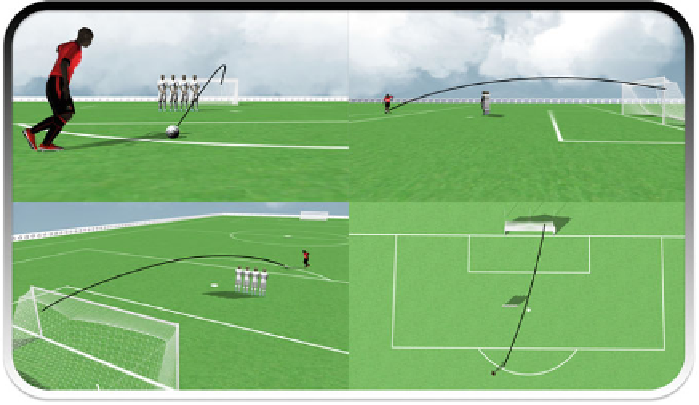Biomedical Engineering Reference
In-Depth Information
Fig. 13.6
Virtual environment
kick conditions (noted i.e. fkL_4_wL with fkL: freekick to the
L
eft, 4:
4
players in
the wall, and wL: wall aligned with the
L
eft goalpost). A training period was carried
out before the experiment to familiarize subjects with the virtual environment and
the task. Five situations were randomly selected and presented to participants that
had to react as in the real experiment.
13.3.3 Results
The distance between the center of the ball and the center of the closest goalkeeper's
hand was calculated in real time and its minimal value is kept for each trial. A three-
way analysis of variance (2 free kicks (right, left)
2 numbers of
players (4, 5)) allows us to highlight significant differences. One can indeed observe
a significant main effect of the number of players in the wall (F(1,352)
×
2walls (right, left)
×
=
11.05,
2
p
49) with a significant better performance for situations with 5
players in the wall (minimal distance ball/hand for 5 players
<
.001,
η
=
1069
.
=
14.39
±
11.14; for
4 players
=
17.88
±
10.01). Another main effect concerns the wall position condition
2
(F(1,352)
49) with a significant better performance
for situations with a wall aligned with the right post (minimal distance ball/hand for
right wall
=
11
.
05, p
<
.001,
η
=
1069
.
09). No difference appeared
between the free kick kicked to the right or the left of the goal.
About the pairwise comparison post-hoc test (Tuckey HSD test), results highlight
two conditions with a significantly lower performance, namely, “fkR_4_wL”: free
kick to the right, 4 players in thewall, wall on the left (p
=
14
.
9
±
10
.
21; for left wall
=
17
.
35
±
11
.
<
0.001 except for fkR_5_wL,
p
<
0.01) and “fkL_4_wR”: free kick to the left, 4 players in the wall, wall on the

